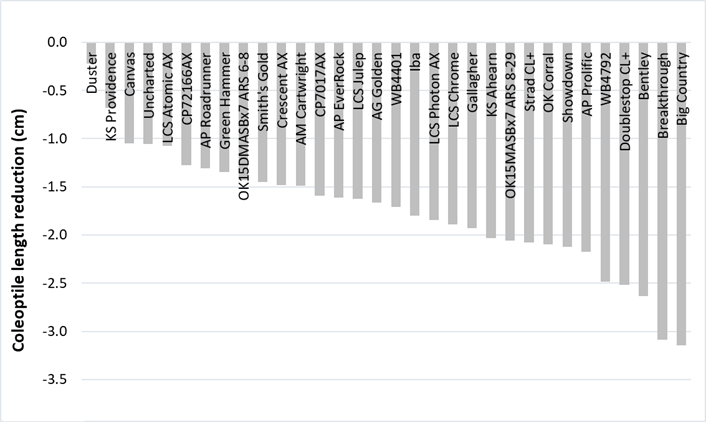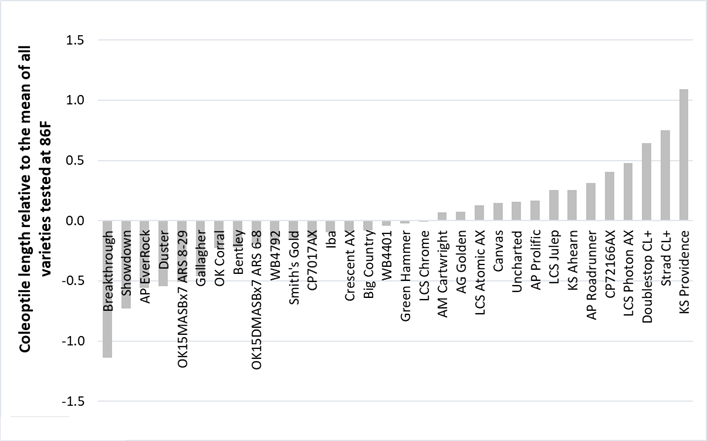Variety Testing & Information Exchange 2022
An ever-evolving number of wheat varieties offered to Oklahoma wheat producers necessitates evaluation and comparison of hard red and hard white winter wheat varieties currently available. To address this need, the wheat variety performance trials evaluated the yield potential and quality characteristics of approximately 20-50 commercially released wheat varieties and 2-5 candidate varieties at approximately 13 locations throughout Oklahoma (Figure 1). Information regarding variety performance and characteristics is distributed through Extension publications, oral presentations and web-based communication outlets (Figure 2). Please see CR-2141, CR-2143 and CR-2135 for detailed results for the 2021-2022 season.
In addition to direct experience and recommendations from crop consultants, the OSU variety trials figure prominently in wheat producers’ decisions on which varieties to plant. These data represent an unbiased source of information to help growers make better-informed decisions and are likely the only source of variety data for a dual-purpose production system in Oklahoma. In the 2021-2022 season, the total number of producer wheat acres represented at the OSU Wheat Variety Trials plot tours were 582,327 acres, and producers valued the information they received at $37 per acre with some values up to $200-300 per acre. One hundred percent of the attendees indicated that the information they received at the field days would influence their variety decision in the future.
Like in many wheat fields in Oklahoma, the southwest trial in Altus experienced severe drought stress throughout the growing season with significant plant or tiller mortality and reduced kernel set, generating statistically unaccountable variability across the field. This data would not be meaningful and misrepresent comparisons among varieties, and thus, this site was not harvested in 2022.
The south central trials in El Reno and Chickasha were used to promptly help producers quantify pre-harvest sprouting damage (via visual ratings and falling number lab analysis) at harvest, which was rated as severe, depending on the variety. In addition, the El Reno trial provided information on variety performance under grain only and dual-purpose systems, and the Chickasha trial provided information about intensive and standard management practices.
For the first time, WIT tested the Oklahoma State University short-season wheat variety (Butler’s Gold) at a late planting date in five locations across the state (Altus, Alva, Apache, Lahoma and Morris). This variety has a fast-growing pattern and is adapted to late planting without delaying harvest. The lack of moisture in early spring had a larger negative impact on late planted wheat as compared to the optimal planted wheat due to its reliance on spring tillering to produce yield. At our trial in eastern Oklahoma (Morris), there were small yield differences among Butler’s Gold planted in October (72 bu/ac) and Butler’s Gold planted in December (66 bu/ac), which demonstrates the yield potential of the variety when soil moisture conditions are favorable. Short-season wheat is ideal for producers wanting to delay planting due to crop rotation practices (e.g., cotton) and as a weed management strategy in the fall. Furthermore, it serves as another tool in the toolbox for when weather (e.g., drought, flood) prevents wheat from being planted at an optimal time.
The seed harvested from demonstration trials in Stillwater was used to evaluate varietal temperature sensitivity during germination and to measure coleoptile length (factsheet will be available soon). This data is important for producers in dual-purpose and graze-out systems where wheat is planted in early to mid-September to maximize fall forage growth. The above-optimal soil temperature (>77F) in early fall could delay germination of varieties sensitive to high temperature and shorten the coleoptile length (Figures 3,4,5).
Our first hollow stem data has been useful to forewarn producers in dual-purpose systems of the need to remove cattle from wheat pasture to reduce grain yield losses from grazing past first hollow stem (Figure 6). The forage yield data has also been useful to demonstrate variety differences in accumulative fall forage production and potential grazing duration among varieties grown in the state. Fall of 2021 included low rainfall and moderate temperatures, which promoted moderate fall forage growth. The variety Green Hammer produced above-average forage for the past three years in Stillwater and on average of three years at Chickasha. Other varieties that produced above-average forage in an average of three years at Chickasha were Gallagher, Showdown and OK Corral. Among the earliest varieties to reach first hollow stem in Stillwater were Gallagher, Green Hammer and the latest, Doublestop CL+. Table 1 shows the classification of the OSU varieties using data from the past four years in Stillwater.
The seed size of varieties tested in the 2021-2022 season varied from 9,080 seeds per pound (i.e., AP Roadrunner) to 19,945 (i.e., Lonerider) seeds per pound (Figure 7). This means that at a fixed seeding rate of 60 pounds per acre, a variety with a big seed size (e.g., 9,080 seeds per pound), would be planted at 544,800 seeds per acre while a variety with a small seed size (e.g., 19,945 seeds per pound), would be planted at 1,196,700 seeds per acre. The OSU varieties Doublestop CL+ and Butler’s Gold averaged 10,748 seeds per pound while Breakthrough and Smith’s Gold averaged 19,650 seeds per pound. Therefore, because of expected differences in seed size between commercially available varieties, seed amounts planted on a constant weight basis can vary drastically when changing varieties from year to year.
The intensive management trial at Chickasha showed a yield increase of 8 bushels per acre on average of all varieties tested and values were as high as 14 bushels per acre depending on the variety (Figures 8 and 9). Protein increased by 1.3% with the intensive management treatment on average of all varieties tested, and values increased up to 2.7% for varieties that likely benefited from the additional topdress N application. This demonstrates to producers that adequate management practices and variety selection can help raise the yield ceiling in the state when the weather cooperates while also benefiting grain quality.
For the third consecutive year, grain protein concentration was reported in real time with grain yield and test weight. Wheat varieties showed a varied response to increasing potential protein levels in the environment; some varieties maintained consistently higher protein than predicted. This data emphasized that genetics play an important role in grain protein production. The OSU Wheat Improvement Team has successfully developed top-performing varieties without losing quality. Further research is needed to continue creating both high-yielding and high-quality wheat.
The 2021-2022 season was marked as one of the worst droughts Oklahoma wheat producers faced in a long time, and grain yield was about 40% lower than expected in most environments. Although the dry weather prevented damage from stripe and leaf rust, it promoted the development of uncommon diseases and pests, such as brown wheat mites and dryland root rot, which infested many fields across the state. Rainfall later in the season also favored pre-harvest sprouting damage. The year 2022 was challenging for Oklahoma wheat growers, and the OSU Wheat Variety Trials served as a source of information to producers, covering all aspects of Oklahoma wheat production (crop management, genetic potential, disease and insect pressure and information exchange).
Figure 1. The 2021-2022 Oklahoma Wheat Variety Performance Tests encompassed 12 locations (i.e., 2,374 plots), including standard and intensive management, grain-only vs. dual purpose, and late-planted short-season wheat varieties across Oklahoma. The data collected from these trials included grain yield in dual-purpose and grain-only production systems, forage yield, response to intensive management, adaptability to different environments, high-temperature sensitivity to germination, coleoptile length, pre-harvest sprouting and grain falling number, lodging, plant height, first hollow stem date, heading date and physiological maturity date. Information can be found in the CR2141, CR-2143 and CR-2135 reports.
Figure 2. The attendance was high at the OSU Wheat Field Day at Lahoma in May 2022.
Figure 3. Producers used the OSU Wheat Variety Test Book to take notes and observe varietal performance last season.
Figure 4. Wheat grain germination sensitivity to high temperature (86F) was measured for selected varieties tested during the 2021-2022 season. Pictured is Yuri de Lacerda Barbosa, visiting scholar.
Figure 5. Coleoptile length was measured at optimal (68F) and high (86F) temperatures for selected varieties tested during the 2021-2022 season.
Figure 6. Pictured are Israel Molina Cyrineu, graduate student, Tyler Lynch, Senior Agriculturalist, and Samson Abiola, graduate student.
Figure 7. Pictured are Tyler Lynch, Senior Agriculturalist, and Samson Abiola, graduate student, measuring coleoptile length at optimal and high temperatures.
Figure 8. Coleoptile length reduction (i.e., coleoptile length at 86F minus coleoptile length at 68F) for selected wheat varieties tested in the 2021-2022 season (top figure). Coleoptile length at 86F, as a deviation from the average of all varieties (bottom figure). The coleoptile length was reduced by 1.7 cm (from 6.5 to 4.8 cm) on average of all varieties at 86F. The coleoptile length of Duster was reduced by 0.2 cm while the coleoptile length of Big Country was reduced by 3.1 cm. Even though the coleoptile length of Doublestop CL + was reduced by 2.5 cm at 86F, its coleoptile length was still 0.5 cm above the mean of all varieties.
Figure 9. Forage yield trials were conducted in Stillwater and Chickasha, and first hollow
stem measurements were collected on a biweekly basis until all varieties reached the
first hollow stem stage. Data was published in CR2141, “Fall Forage Production and First Hollow Stem Date for Wheat Varieties,” during
the 2021-2022 Crop Year. Pictured is Tyler Lynch, Senior Agriculturalist.
| Company | Variety | FHS |
|---|---|---|
| OGI | Baker's Ann | Early |
| OGI | Skydance | Early |
| OGI | Gallagher | ME-I |
| OGI | Green Hammer | ME-I |
| OGI | Strad CL+ | ME-I |
| OGI | Bentley | I-ML |
| OGI | Duster | I-ML |
| OGI | Uncharted | I |
| OGI | Showdown | I-ML |
| OGI | Smith's Gold | I |
| OGI | Iba | I |
| OGI | OK Corral | I |
| OGI | Big Country | I |
| OGI | Breakthrough | I |
| OGI | Uncharted | I |
| OGI | Doublestop CL+ | Late |
Figure 10. Seed size and seeding rate for standard and intensive management trials in the 2021-2022 OSU Wheat Variety Performance Tests. Complete table with information for each variety can be found in CR-2143.
Figure 11. Grain yield in bushels per acre for the 2021-2022 OSU Wheat Variety Performance Tests with intensive management (Apache and Morris) and standard vs. intensive management comparisons (Chickasha and Lahoma) averaged across all varieties tested. Information on individual variety response to management can be found in CR-2143.
Figure 12. Grain protein concentration for the 2021-2022 OSU Wheat Variety Performance Tests with intensive management (Apache and Morris) and standard vs. intensive management comparison (Chickasha and Lahoma) on average of all varieties tested. Information for individual varieties response to management can be found in CR-2143.













